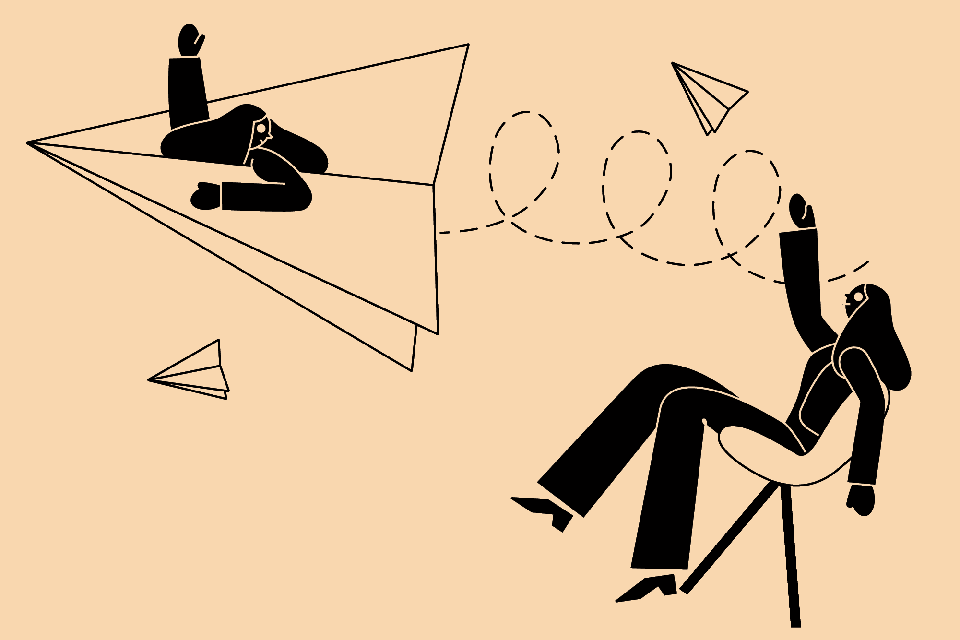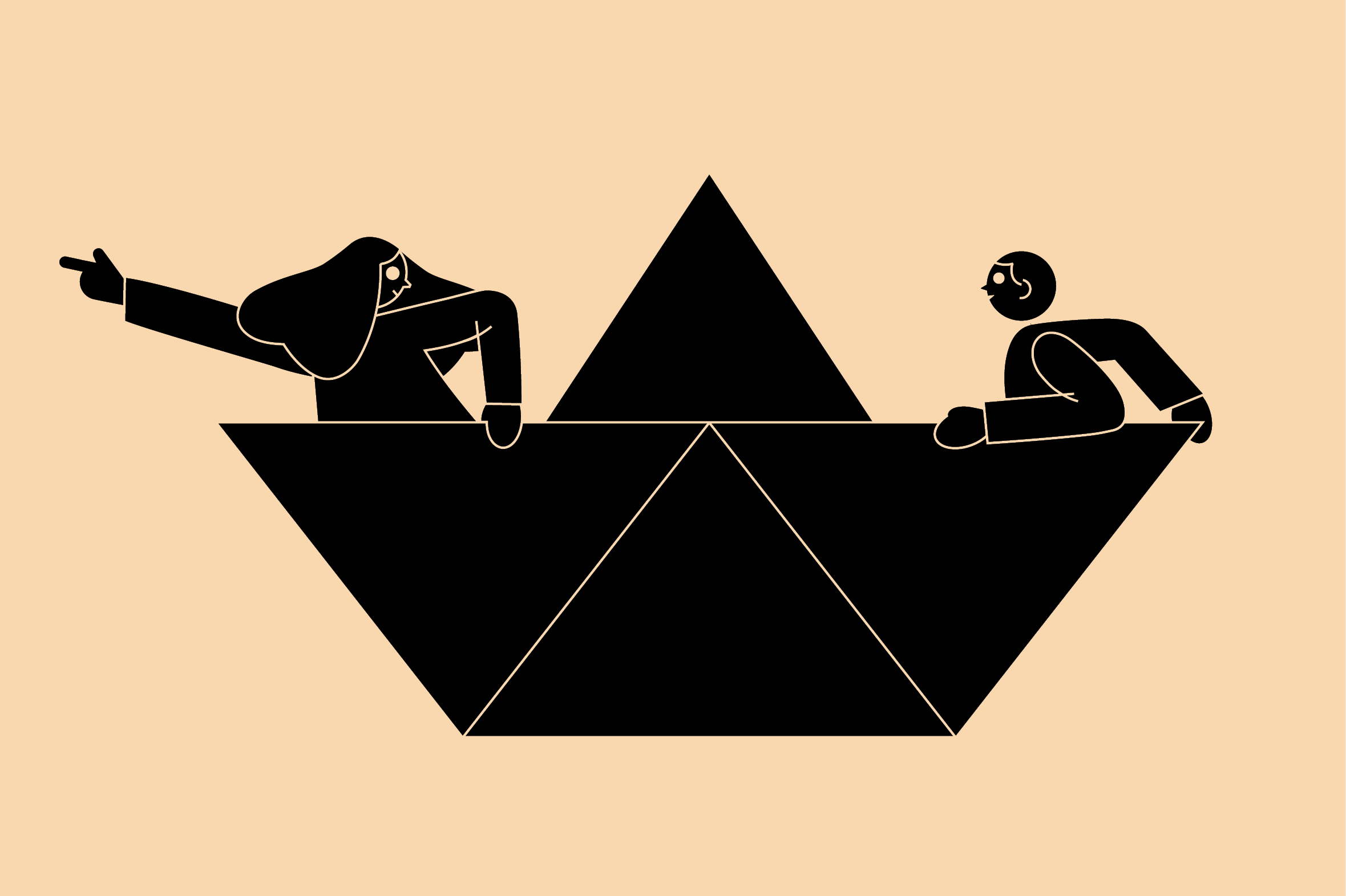At Studio Moross, the designers take care of the initial conversations with the client about budgets and timelines, and client feedback goes directly to the designer who’ll be working with it. For the One Direction project, it all started when the studio was commissioned to make a minute-long animation for the end of the band’s 2014 tour. That quickly moved on and the studio found itself working on the entire stage design, new album artwork and animations. Charlie has been project managing the One Direction work since the beginning of the year, meeting with the band’s label [Syco]. The band gets final sign-off on all design work, and Kate meets with them to discuss it.
For a project so high-profile and involving numerous stakeholders, we were surprised to hear Charlie describe it as having “gone smoothly” when the studio offered the creative freedom to take the look and feel into a “more mature direction” for the band’s newest album. For now, the designer thinks that the studio’s lack of full time production staff or project managers is working well. “When we have a pitch we speak to the client, act as creative director on that project and discuss with the other team members to see who has the time and the skills to work on it. We do the presentation and work on the budget, but at the same time you’re being the designer,” he says.
“At the scale we’re at now it doesn’t seem to be a problem, but if you’re managing three or four projects in one go and you have a day when you’re going to meetings all day and there’s no designing, then that does set you back. Maybe as a time thing it might benefit us.”
Studio Moross designer Olly Chapman adds: “One problem with working with a project manager is that sometimes they start making creative decisions as a creative, which aren’t necessarily the right decision creatively. If you’re talking directly to the client you can immediately explain why a certain decision was made.”
Commission is a small south London-based studio which was founded two years ago by creative directors David McFarline and Christopher Moorby. In their early days, they had no project manager or producer roles, but earlier this year the fledgling agency found itself shortlisted as the only UK agency invited to pitch for a huge job: designing a new visual identity for fashion house DKNY. The project had come about when Donna Karen stepped away from the brand and two new creative directors (Maxwell Osborne and Dao-Yi Chow of Public School) were taken on, as well as chief image officer (ex-Apple creative director of global marketing communications) Hector Muelas. Despite pitching against seven other more established agencies from around the globe, Commission won, and brought in Grace Davies as the project manager.
Grace had worked with Christopher at Made Thought, and they knew they worked well together. As a young agency with smaller projects under their belt, the realities of working with a client as huge as DKNY needed a PM who not only knew exactly what they were doing, but were trusted and confident working with big name brands.
Grace’s first task was to translate the brief into a project proposal, and work out the costings and resources needed to complete the project. Grace says: “I had to plan each project within the rebrand, and work out with Christopher and David how long each element would take which our fees would then be calculated against. At this stage it’s my job to present the project fees and build a project timing plan to illustrate how and when each part of the project would be realised. I am then responsible for sharing those with the client and from then on going between the design team and the client as we refine the list of deliverables and related fees. There’s a lot of back and forth and negotiation to get to a point where everyone’s happy.”
The project was broken into four stages: creating the new identity for the brand; designing the New York Fashion Week invitations and press kits; redesigning the entire DKNY packaging suite; and developing a DKNY brand guidelines document. Once the identity was developed and signed off it was quickly put to the test with the upcoming NYFW show to be held at One World Trade Centre in New York, the invitations and press kits of which were the first public facing glimpse of the new identity, so there was a lot of pressure to create something spectacular. Following on closely was the packaging redesign which was split across main line collection, e-commerce, hosiery, watch, eyewear and kids. This stage is still ongoing and will hit stores next year, as are the development of the DKNY brand guidelines which are constantly updated and shared as the project progresses.
“The NYFW invitations were an amazing, but very stressful part of the project - the brief was incredible, but timings were tight,” says Grace. “Maxwell and Dao-Yi’s theme for the collection was ‘missing pieces’ inspired by Sol Lewitt’s Manhattan series. We wanted to take that theme and design something special and tactile to tell that story from the moment guests received their invitations. Previously in the year Christopher and David met an incredible printer in Paris, Impremerie du Marais, and so we spoke to them about realising our concept. We wanted to use a bevelling technique they were pioneering to do something really innovative with paper. A lot of my job is about speaking with the designers and the suppliers to work out if certain ideas are possible.”
Throughout the project Grace acts as a go-between with the client and studio on timings and budgets. “It’s really important to have positive, strong relationships with both the client and the team on such a fast paced project. I have to make sure that the team know what their deadlines are each week and understands what we’re delivering at each stage of the project. I have to speak with the creative team, suppliers and people we want to work with to see how far we can push an idea,” she says.
It all sounds enormously time consuming. Not to mention intensely stressful, playing as a sort of creative piggie in the middle. But while Grace has worked jobs where 7.30am – 9pm days were the norm, she says that even on busy days at Commission a working culture has been created where she very rarely has to work late. “I think in this industry sometimes it’s expected that you work really long hours, studio culture can almost get competitive,” says Grace. “I think you have to be really open and transparent with a client. Rather than pretending everything’s going fine, just ask for more time if you really have to rather than killing the creative team. Especially with something like design, you reach a moment where you crack it. And sometimes you have to work through a lot of ideas to get a great solution.”
YCN STUDIO/LOVERS
GREEN MAN FESTIVAL REBRAND
ycn.org
Green Man Festival was rebranded in 2012, launching a much-lauded and impressive new identity. Held each year in Wales’ Brecon Beacons, the family-run festival was keen to find an agency that understood its values and its staunch refusal to accept corporate sponsorship. Ally Carter, who studied graphic design at Brighton University, was the project manager on the rebrand, for which the agency was approached to pitch having been recommended by an illustrator known to both parties. “It was a lovely brief as they just showed us what they had and told us what they liked, what they didn’t and what they did and didn’t want,” says Ally. “It was clear how much they understood both their audience and their product with such clarity. That’s quite rare.”
Working on the project was something of a dream for Ally, who’d grown up in the area around the festival – a small town where it played a significant role in the shape of the summer. “Green Man is very conscious about the locality, and the Welshness played into it,” she says. “They support the local economies all year round and with the local schools, so it was super helpful being from round there.”
The team working on the job was very small, with around three designers and a director, and Ally worked across a spectrum of roles including production and client services. For the initial pitch, she undertook reams of research about the festival and its pagan ties. The identity was based around this sort of spiritual symbolism, and so the historical element was vital.
Ally says: “You can go so deep into researching the history and imagery in the world of paganism. You have to really get to grips with understanding the symbolism and finding the things that would translate beautifully into a visual identity, and picking out visual motifs and symbols. It helps so much in roles like this to have a creative background as there’s so many crossovers. You have to understand which things are going to be relevant to a designer.”
After winning the pitch, Ally started on the planning. This involved looking at how many hours each week the different members of the team would need to be spending on the project, and booking regular catchups with them and the client. A big list of everything that would need to be created, from a website to a signage to wristbands was created, and prioritised in order of when it would need to be delivered.
“Some of the deliverables might be more a rolling thing, and then you get a list of hard deadlines. Once these are worked out you plan when you need to deliver what, and who’s needed for those things so you can plan people’s time around those and when they’re free to do the work,” says Ally.
Ally assisted with research across blogs and via contacts, and in the end the team found the work of Sarah Mazzetti. Her unusual colour palettes, abstract shapes and surreal scenes were perfect for the job. Ally worked up her contract, and Sarah was briefed to create designs that would appear across all festival collateral. Evernote, says Ally, is a key PM tool for commissioning work, allowing you to store notes and images for potential collaborators.
Another key commission for the Green Man project were for a typeface, created in-house and digitised by Colophon foundry. A poem was also commissioned that appeared on the festival site. Throughout the project, Ally’s overarching role was to make sure the studio was running well in a day-to-day sense, making sure everyone knew what they needed to be working on and keeping track of house and budgets, as well as remaining in constant contact with the client. Sounds like a lot to be juggling. “I think in a PM role you have to have emotional intelligence you can’t be volatile or confrontational, you have to be very patient,” she says. “You have to be 100% prepared to admit you’re wrong and not feel threatened or worried about that. It’s never about seeing who’s going to break first, it’s all about showing you understand what everyone’s going through if things get tough.”

